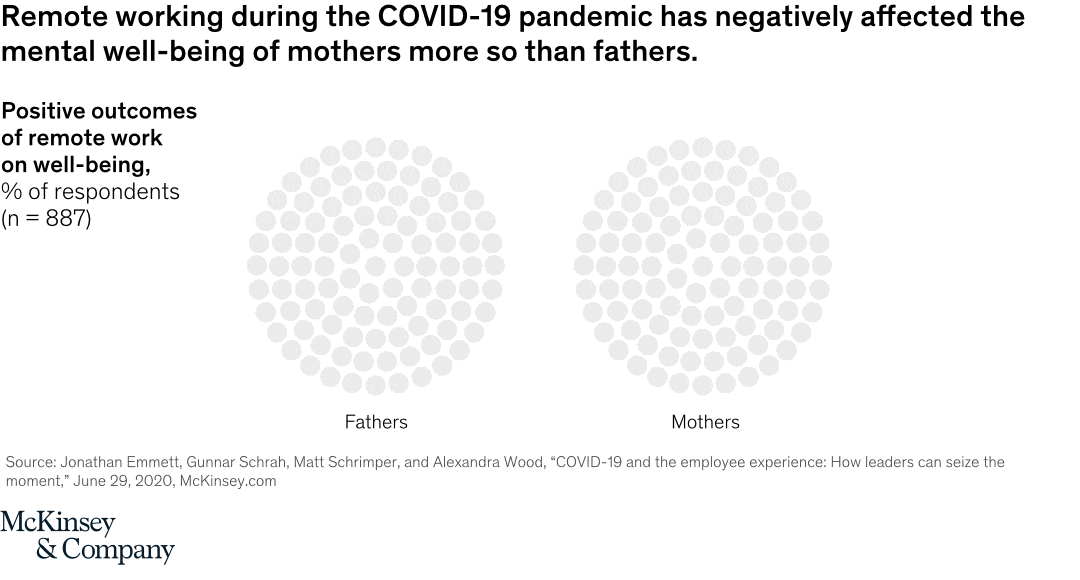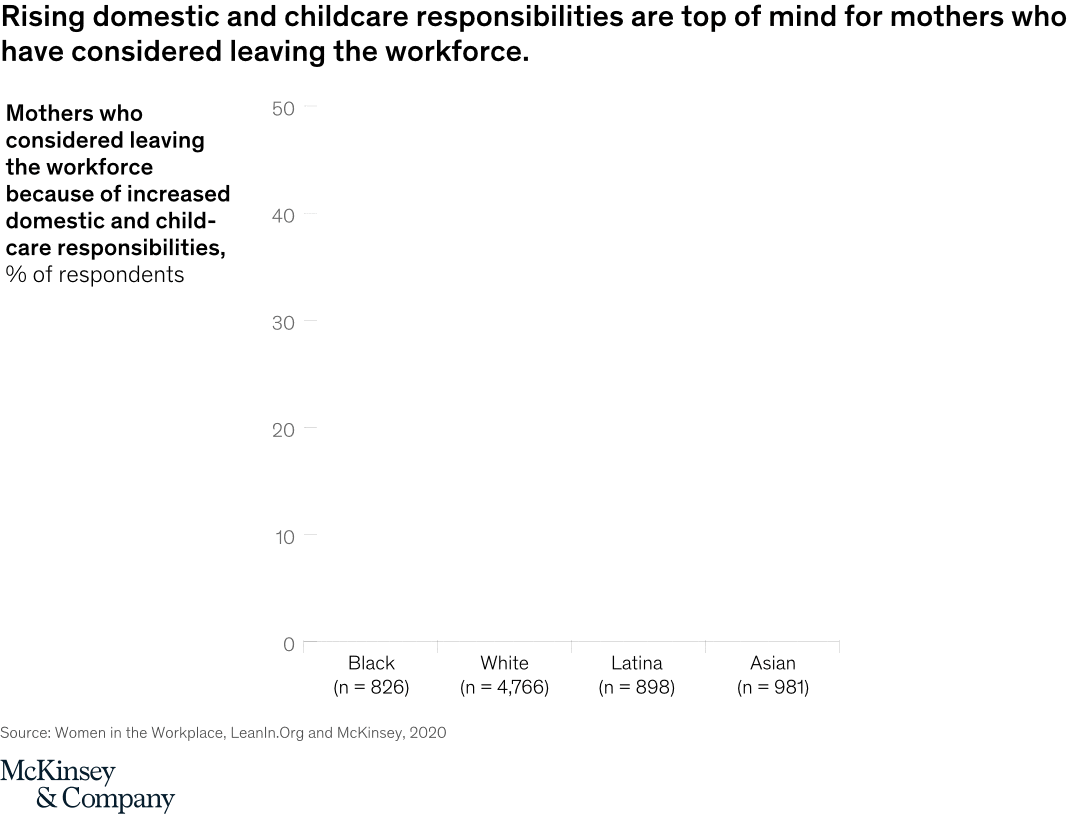Working mothers are a resilient group, accustomed to juggling work responsibilities and family time with aplomb. Before the COVID-19 crisis, they had slowly been making progress in the workplace. But the challenges of the past year have made many wonder whether all the scrambling has been worth it.
McKinsey’s 2020 Women in the Workplace report, conducted with LeanIn.Org, revealed a startling statistic: one in four working women in North America said that they were considering downshifting their careers or dropping out of the workforce entirely. For working mothers, and particularly those with young children, the number was one in three.
Research from McKinsey over the past year shows just how dramatically the pandemic has affected working mothers. They’ve grappled with a “double shift” of household responsibilities, mental health challenges, a more difficult remote-work experience, and concerns about higher rates of unemployment—particularly among mothers of color and single mothers. These burdens come on top of structural barriers for working women, including being the “only” woman in the room and playing an allyship role for others.
We know that women’s advancement in the workforce matters; companies with more women executives are more likely to outperform those with fewer senior women. Working mothers comprised nearly a third of the female workforce in the United States in 2020,1 so employers cannot afford to ignore or minimize the hardships that millions of women now face. If organizations respond well by building a more flexible and empathetic workplace, they can retain the employees most affected by the pandemic and nurture a culture in which working mothers have equal opportunity to achieve their potential. And there are signs that this is beginning to happen.
In this article, we explore McKinsey analysis that highlights the challenges facing working mothers, coupled with actions that companies can take to help these women get back on track.
At the beginning of 2020, the representation of women in corporate America was trending in the right direction. Between January 2015 and January 2020, the number of women in senior-vice-president positions increased from 23 to 28 percent, and in the C-suite from 17 to 21 percent.

The pandemic stall: Working mothers hit a wall
Our research shows that before the pandemic, working mothers had similar career ambitions as working women overall. In fact, the Women in the Workplace data from 2019 indicated that working mothers in North America appeared to register higher ambition numbers in several key categories (Exhibit 1).

But the pandemic altered that equation: the added burdens at work and at home since the COVID-19 crisis began have pushed roughly 33 percent of working mothers to consider downshifting their careers or leaving their jobs altogether. In a workforce that generally begins at gender parity but drops off steeply throughout the promotion pipeline, a step back from employment—and a related drop in promotion rates for women—may upend years of progress.
Mental health has taken a hit
Mental health challenges and burnout have emerged as significant issues for all workers during the pandemic. A Kaiser Family Foundation survey in 2020 found that 45 percent of Americans feel that the COVID-19 crisis is harming their mental health. Globally, the impact on women has been striking: our survey on diverse employees showed that across both advanced and developing countries, mothers (at 75 percent) are more likely than fathers (69 percent) to be struggling with mental health concerns.
In a separate survey on the employee experience, McKinsey looked at how remote work was affecting different groups and found that while all workers were experiencing some degree of disruption, the impact on working mothers versus working fathers was stark. Remote-working mothers showed much lower levels of well-being than remote-working fathers (Exhibit 2).

“Women with children always have some stigma attached to them in the workplace. I never want that stigma to be attached to me and my work.”
The ‘double shift’ burden grows
Decades of research show that women do significantly more housework and childcare than men—so much so that women who are employed full-time are often said to be working a “double shift.”
Now, women, and mothers in particular, are taking on an even heavier load. Mothers are more than three times as likely as fathers to be responsible for most of the housework and caregiving during the pandemic. In fact, they are 1.5 times more likely than fathers to spend an additional three or more hours per day on housework and childcare. Single mothers have faced even greater loads—10 percent more single mothers report spending an additional three or more hours per day on housework and childcare than mothers overall (Exhibit 3).

Working mothers aren’t being recognized for time spent, either. More than 70 percent of heterosexual fathers in dual-career couples think that they are splitting household labor equally with their partner during the COVID-19 crisis, though only 44 percent of heterosexual mothers in dual-career couples agree.
And the home-care burden is spilling over to work. Nearly a quarter of mothers said they worried that their work performance was being judged negatively because of their caregiving responsibilities, compared with 11 percent of fathers.
“I have weeks when I feel burned out. Before the pandemic, my parents helped with childcare, but now everything falls on me. I feel overwhelmed at least two or three days a week.”
For mothers of color, a double shift—and then some
The pandemic has affected working mothers of color disproportionately. Latina mothers are 1.6 times more likely than white mothers to be responsible for all childcare and housework, and Black mothers are twice as likely to be handling these duties for their families (Exhibit 4).

Latina and Black women are more likely to be their family’s sole breadwinner or to have partners working outside the home during the COVID-19 crisis, so leaving the workforce or downshifting may not be a realistic option. Of mothers who have considered leaving the workforce, Asian and Latina mothers were more likely to say that their decision was related to domestic and childcare responsibilities (Exhibit 5)

Black and Latina women were already underrepresented in the workforce in 2020, particularly at higher levels of the organization. In fact, for every 100 men promoted to manager, only 85 women were promoted—and the gap was even larger for Black and Latina women, with only 58 Black women and 71 Latinas being promoted for every 100 men.

Potential grows for long-term career loss
The gender-regressive effects caused by the COVID-19 pandemic harm not only immediate economic security for millions of women and their families but also long-term economic growth and social stability, research from the McKinsey Global Institute has found.
In the United States, pandemic-related job losses have disproportionately affected minorities, women, and other vulnerable workers. During the heart of the crisis, Black and Hispanic workers faced 1.6 to 2.0 times the unemployment rates of their white counterparts; households with less than $30,000 in annual income faced double the unemployment rates of higher-income households.
The unemployment crisis has been acute for all mothers—Black, Latina, Asian, and white. Jobless rates for single mothers, which are drawn from all of those groups but are particularly inclusive of mothers of color, remain far above prepandemic levels, soaring from a prepandemic level of 9.8 percent to peak at more than 28 percent in May of 2020, nearly twice the overall national peak of 14.6 percent. It remained at 18.8 percent in February of 2021. By comparison, unemployment among mothers in two-parent households in the United States rose from a prepandemic level of 7.2 percent to 13.6 percent in February (Exhibit 6).

However, the recent outlook for women’s employment has improved slightly. In March, unemployment rates for women dropped to nearly the same level of decline experienced by men, suggesting a rise in household employment, according to the White House.2

The value of unpaid-care work performed by women is $10 trillion, or 13 percent of global GDP, according to the McKinsey Global Institute. Interventions to tackle this problem include better recognition of unpaid work, reducing the amount of unpaid work, and rebalancing it between men and women.
How companies can respond
During this crisis, organizations have increased resources to help employees, including mothers, cope with heightened challenges. However, as pandemic-related stress and burnout continue into a second year, employers must not take their foot off the gas. Here are several actions they can continue, augment, or refine.
Help mothers stay in the workforce
To start, organizations should ensure that working mothers have the support they need, particularly with respect to childcare, work–life flexibility, and performance reviews.
Adjust childcare-related policies and programs. Companies can establish policies that are designed to mitigate the uneven burden on mothers, including increased childcare support and other related programs. Some have provided emergency childcare resources or subsidized childcare, tutoring programs for school-aged children, or other programs. These policies should not be viewed as short-term emergency actions during the pandemic but rather as long-term adjustments.
Take an intersectional approach. Companies should acknowledge and address the unique challenges facing mothers of color and single mothers. For instance, recognizing that Black women have a different experience—both in and outside the workplace—from Black men and other women can help organizations tailor solutions to set goals and track representation. To foster an inclusive culture that supports and values Black women, companies can focus on formal and informal support structures such as mentorship and allyship programs. An emphasis on intersectionality also helps those women who experience being an “only”—for example, being the only person of their gender in the room.
Reset norms around flexibility. The need for greater work–life flexibility is the number-one issue raised by both women and men at work, and companies have responded by increasing flexibility over the past five years. The need for flexibility at work has only grown during the pandemic. According to McKinsey research, remote-working mothers who report more effective time management and schedule flexibility—both key indicators of work–life balance—are three times more likely than those who report work inefficiency and schedule inflexibility to have a positive state of well-being.
Employees with young children are more likely to prefer primarily remote-working models and flexible work locations, our recent survey on the future of remote work shows, with only 8 percent suggesting that they would like to see a fully on-site model in the future (Exhibit 7).

The cultural context around paternity leave is changing, as more countries and companies offer the benefit to new fathers. Worldwide, 90 out of 187 countries offer statutory paid paternity leave, with almost four in ten organizations providing paid leave above the required minimum. But despite this shift in support, less than half of eligible fathers in OECD countries take the benefits offered to them.

Normalize the use of flexible programs. As companies establish childcare policies and create flexible working models, they should encourage both men and women to participate in them. Our survey on the employee experience indicated that the top priority for remote-working women is to balance work and private life. For remote-working men, that need didn’t even rank in the top ten. Reducing that gap is crucial for working mothers.
Parental leave is a great example of the difference in expectations between working mothers and fathers. We are accustomed to thinking of maternity leave as the big early-childcare solution, but paternity leave is now an option as well, as more organizations are offering it. A recent McKinsey–McGill University survey of men who have taken paternity leave found that they were unanimously glad they took it, with most saying that it helped them form stronger bonds with their partners and children. A work culture that encourages taking leave, policy support from their employer, and an unaffected promotion timeline all helped them make the decision to take paternity leave, respondents said.
Organizations should take these principles to heart, applying them beyond parental leave to all flexible programs. By equalizing and normalizing participation in these programs, companies will ensure that working mothers aren’t the only ones affected in terms of career trajectories.
Remove bias in people processes. Performance reviews are crucial, but they can also become forums for bias that can inhibit the progress of mothers. To ensure that fair and objective performance criteria are tied to work output, it is important to revisit any performance markers that may either be irrelevant or misleading. For example, to do quality work and to be a good team member, is it always necessary to be accessible and to have a lightning-fast response time?
Make sure the appropriate criteria are used effectively when it comes to promotions. Consider a checklist of items for minimizing bias: require unconscious-bias training for the employees involved in promotion decisions; provide reminders about how to avoid unconscious bias, and designate a team member to call it out; and track outcomes to check for bias.
“There’s a kind of magnifying glass that if my light doesn’t look green to show I’m available to talk, or if I’m not in a meeting, then I’m not working.”
Create opportunities for mothers to return
Even with all the actions we list above, the fact remains that working mothers are leaving the workforce in higher numbers than before. The following steps can help them return:
Adjust the hiring process. Help set the expectation that mothers can return to the workplace by using a different hiring process—one that does not question their gap in employment. Ensure that job descriptions and interviews focus on the fundamental capabilities required to do the job well, without added dimensions that could create bias against women and mothers. For example, remove requirements for recent experience or for knowledge of new technology trends that can be learned on the job. Be open to investing more heavily in training candidates who have the fundamental skills and potential for growth.
Implement ‘returnships.’ Companies should consider creating returnship programs to help women reenter the workforce gradually but without losing prior progress. Many Wall Street companies began to use them during the 2008–09 financial crisis to help returning women establish an upward trajectory.3 For example, JPMorgan Chase implemented a reentry program in the form of a paid fellowship for women returning to the industry. The 2019 Women in the Workplace report revealed that company leaders believe returnships and other similar programs have helped them develop and retain talented women, contributing to their representation of women in the C-suite at more than double the industry average.
Create on-ramp programs. Develop processes that allow mothers to adjust to returning to work, recognizing that the childcare and other responsibilities that prompted their departure have likely not disappeared. This can include formal mentorship and sponsorship programs, as well as placement with managers who are equipped to help mothers be successful as they navigate new challenges.
Companies that take action to help working mothers—including tailoring policies and programs and normalizing flexibility and leave for all employees—will create a better environment for mothers to stay in the workplace and thrive. For those women who must leave, policies that help them return when they are ready not only help women’s careers but also ensure that companies don’t lose all that talent and experience. The choices that companies make today will have consequences far beyond this difficult pandemic era, influencing gender equality in the workplace for decades to come.


